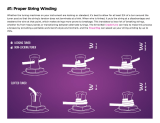
Changing Steel Strings the (new, improved) Taylor Way
by Anthony Adams / photos by Rita Funk-Hoffman
I
n the Summer 2004 issue, we showed the Taylor-recommended
way to change strings on our Nylon Series guitars. This time, we
tackle the same process on the more common steel-string guitar,
both because we’ve received requests for this vital information, and
because our thinking on the subject has changed a bit since we did
our first major piece about strings in the Spring 1995 issue.
Indeed, there are as many variations on the process of changing
steel strings as there are players, and not all methods are equally
effective. Some interfere with tuning (too many wraps) and others
make strings susceptible to breakage (too few wraps). Developed
over decades of experience, the current Taylor Guitars method has
proven to provide outstanding results for all steel-string guitars.
1. Position yourself comfortably to change strings. A workbench is
ideal, but good results can be obtained by sitting on a sofa and rest-
ing the neck of the guitar on the sofa arm. Loosen the bass strings
— 6th (Low E), 5th
(A), and 4th (D) — by turning the tuners
clockwise with your left hand while holding tension on the string
with your right hand. Loosen the treble strings — 3rd (G), 2nd (B),
and 1st (High E) — by turning the tuners in a counter-clockwise
direction.
2. When all the strings are loosened, use wire cutters to remove the
bridge pins. Using the saddle as a cantilever, exert gentle pressure
to pull out the bridge pins. Now, gently lift out the old strings from
the bridge and discard them. With the old strings literally out of the
way, you have a great opportunity to clean your fretboard. Cover the
guitar’s soundhole with a towel and clean the fretboard with .0000
gauge steel wool. You can rub pretty hard without damaging the
fretboard, but be careful not to let it touch the body!
3. Once your fretboard is
clean it’s time to re-string.
Begin by inserting the ball
end of the 6th string, fol-
lowed by the bridge pin.
Push the bridge pin down and pull up on the ball end until it catches.
Pull gently on the string to verify that it’s “locked” in place.
4. Stretch the 6th string over the peghead. Using wire cutters, trim
the string at the 5th string post.
5. Turn the 6th string tuner so the hole in the tuner is at a 45-degree
angle, then insert the 6th string and turn the tuner in a counter-
clockwise direction to tighten the string. The string end should
protrude approximately 1/8th of an inch from the tuner hole.




